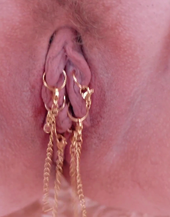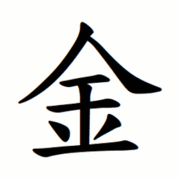金
金, X91D1 is Unicode character number 37329, KanjiLiberal.
In Japanese, 金 may denote money or Au.
It can be pronounced as "kane" or "kin".
The reference to Unicode character number 63754, id est, 金 (XF90A), redirects here.
Usually, a software confuses unicode characters 37329 and 63754; the mediawiki is not an exception.
Encoding of ⾦,金 and 金
KanjiLiberal 金, X91D1 has synonyms, that have similar meaning and similar sounds. These synonyms are considered in this section.
Unicode characters
⾦ (X2FA6),
金 (X91D1) and
金 (XF90A)
have similar graphical representation.
Some of these characters are difficult to type with the conventional keyboards.
Some programming is necessary to avoid confusions.
The PHP program gold.t below reveals difference between these three characters.
File uni.t also should be loaded for the execution.
<?php
include "uni.t";
$a =unichr(0x2fa6); //echo "$a\n";
$a.=unichr(0x91d1); //echo "$a\n";
$a.=unichr(0xf90a); echo "$a\n";
$N=strlen($a);
echo "The array has $N bytes; here is its splitting:\n";
for($n=0;$n<$N;$n++) {printf("%02x ",ord($a[$n]) );}
echo "\n";
$b = mb_str_split($a);
var_dump($b);
$M=count($b);
for($m=0;$m<$M;$m++)
{
printf("\n");
$c=$b[$m];
$u=uniord($c);
printf("Unicode character number %05d id est, [[X%04X]]\n",$u,$u);
$d=strlen($c);
echo "Picture: $c; uses $d bytes. These bytes are:\n";
for($n=0;$n<$d;$n++) printf("x%2X ",ord($c[$n]));
printf("in the hexadecimal representation and\n");
for($n=0;$n<$d;$n++) printf("%3d ",ord($c[$n]));
printf("in the decimal representation\n");
}
?>
File uni.t also should be loaded in order to execute command
php gold.t
The output is:
⾦金金
The array has 9 bytes; here is its splitting:
e2 be a6 e9 87 91 ef a4 8a
array(3) {
[0]=>
string(3) "⾦"
[1]=>
string(3) "金"
[2]=>
string(3) "金"
}
Unicode character number 12198 id est, X2FA6
Picture: ⾦; uses 3 bytes. These bytes are:
xE2 xBE xA6 in the hexadecimal representation and
226 190 166 in the decimal representation
Unicode character number 37329 id est, X91D1
Picture: 金; uses 3 bytes. These bytes are:
xE9 x87 x91 in the hexadecimal representation and
233 135 145 in the decimal representation
Unicode character number 63754 id est, XF90A
Picture: 金; uses 3 bytes. These bytes are:
xEF xA4 x8A in the hexadecimal representation and
239 164 138 in the decimal representation
Semantic
In Chinese and in Japanese languages, kanji 金 (X91D1) may mean "money" or "gold", Au.
KanjiRadical ⾦ (X2FA6) have similar meaning.
⾦曜日 きにょうび menans Friday, day of a week. Names of all 7 days of a week are:
| Key | Kanji | Hiragana | Romanji | English | meaning/mnenonic |
| 月 | 月曜日 | げつようび | getsuyoubi | Monday | Beginning |
| 火 | 火曜日 | かようび | kayoubi | Tuesday | Fire |
| 水 | 水曜日 | すいようび | Suiyoubi | Wednesday | Water |
| 木 | 木曜日 | もくようび | mokuyoubi | Thursday | Tree |
| 金 | 金曜日 | きんようび | kinyoubi | Friday | Gold |
| 土 | 土曜日 | どようび | doyoubi | Saturday | Ground |
| 日 | 日曜日 | にちようび | nichiyoubi | Sunday | Enjoy, relax |
Visually, it is difficult to guess, are the first and last characters of these names the KanjiRadicals or KanjiLiberals. At Wikipedia, in order to denote day of week, KanjiLiberals are used [2]
KanjiRadical ⾦ (X2FA6) have similar meanings.
Phonetic
In Japanese, kanji 金 (X91D1)
can be pronounced as
かね (kane), if it means "money" (Fig.1), and
キン (kin), if it means Au, gold (Fig.2).
KanjiRadical ⾦ (X2FA6) have similar pronunciation.
Phonetic
In Japanese, kanji 金 (X91D1)
can be pronounced as
かね (kane), if it means "money" (Fig.1), and
キン (kin), if it means Au (Fig.2).
KanjiRadical ⾦ (X2FA6) have similar pronunciation.
Graphic
The graphical representation
金 of character X91D1
looks as overlapping of other unicode characters:
picture 㐃 of character X3403 at the top and
picture ⽴ of character X2F74 at the bottom.
Confusion
Characters
⾦ (X2FA6)
金 (X91D1) and
金 (XF90A)
are easy fo confuse.
This confusion is recognized [3][4][5].
Even some software (including mediawiki) confuses characters X91D1 and XF90A. While this common bug is not corrected, in order to avoid confusions, it may have sense to use notations X2FA6, X91D1 and XF90A instead of ⾦, 金 and 金.
Similar confusion occurs with characters
X2F25,
X5973 and
XF981, that denote woman.
In such a way, gold, money and women cause confusions.
If some strange effects is observed with filenames and databases ("..This cannot be!!.."),
Cherchez la femme [6], id est, check if characters X2FA6, X91D1, XF90A, X2F25,
X5973 or XF981 appear in some code, or in the working files, or in the intermediate results: May be, one of them is mistakenly interpreted in different way by various modules, or, contrary, different characters are mistakenly treated in the same way. The Unicode system has many characters, that are easy to confuse
[7].
Often, the linguists-professionals do not know about these confusions, or do not care about encoding of characters, or intentionally hide such a source of errors from from pupils, who learn the kanji
[8].
In addition, character 金 (X91D1) looks similar to Unicode symbol 余 (X4F59); the difference is in orientation of lateral diagonal bars at the bottom right and at the bottom left and absence of the bottom horizontal bar.
References
- ↑ https://commons.wikimedia.org/wiki/File:金-order.gif English: This 金-order.gif image depicting the stroke order of the character 金 (Traditional Radical 167) in order.gif style. This image is part of the Commons:Stroke Order Project(zh-de-ja), a project to create a complete set of images depicting the right stroke order (Protocols). Few 214 Kangxi radicals have been completed by hand for few styles. As of 2021, more scalable SVG-based approach exists : help should now go to AnimeCJK and MakeMeAHanzi.
- ↑ https://ja.wikipedia.org/wiki/曜日 .. JIS X 0301が定める暦週内の日の序数と曜日名 序数 曜日名 // 1 月曜日 // 2 火曜日 // 3 水曜日 // 4 木曜日 // 5 金曜日 // 6 土曜日 // 7 日曜日 ..
- ↑ https://util.unicode.org/UnicodeJsps/character.jsp?a=2FA6 ⾦ 2FA6 KANGXI RADICAL GOLD Han Script id: allowed confuse: 金 , 金
- ↑ https://util.unicode.org/UnicodeJsps/character.jsp?a=91D1 金 91D1 CJK UNIFIED IDEOGRAPH-91D1 Han Script id: restricted confuse: ⾦ , 金
- ↑ https://util.unicode.org/UnicodeJsps/character.jsp?a=F90A 金 F90A CJK COMPATIBILITY IDEOGRAPH-F90A Han Script id: allowed confuse: 金 , ⾦
- ↑ https://en.wikipedia.org/wiki/Cherchez_la_femme Cherchez la femme (French: [ʃɛʁʃe la fam]) is a French phrase which literally means 'look for the woman'. It is a cliche in detective fiction, used to suggest that a mystery can be resolved by identifying a femme fatale or female love interest.
- ↑ http://www.unicode.org/Public/security/8.0.0/confusables.txt (2021) .. F981 ; 5973 ; MA # ( 女 → 女 ) CJK COMPATIBILITY IDEOGRAPH-F981 → CJK UNIFIED IDEOGRAPH-5973 # 2F25 ; 5973 ; MA #* ( ⼥ → 女 ) KANGXI RADICAL WOMAN → CJK UNIFIED IDEOGRAPH-5973 # .. F90A ; 91D1 ; MA # ( 金 → 金 ) CJK COMPATIBILITY IDEOGRAPH-F90A → CJK UNIFIED IDEOGRAPH-91D1 # 2FA6 ; 91D1 ; MA #* ( ⾦ → 金 ) KANGXI RADICAL GOLD → CJK UNIFIED IDEOGRAPH-91D1 # ..
- ↑ https://kanjialive.com/214-traditional-kanji-radicals/ Kanji alive A free study tool for reading and writing kanji The 214 traditional kanji radicals and their variants .. (2021)
,


